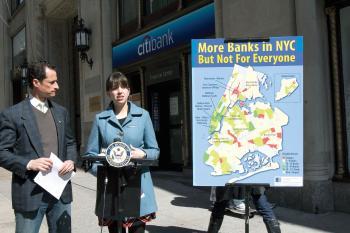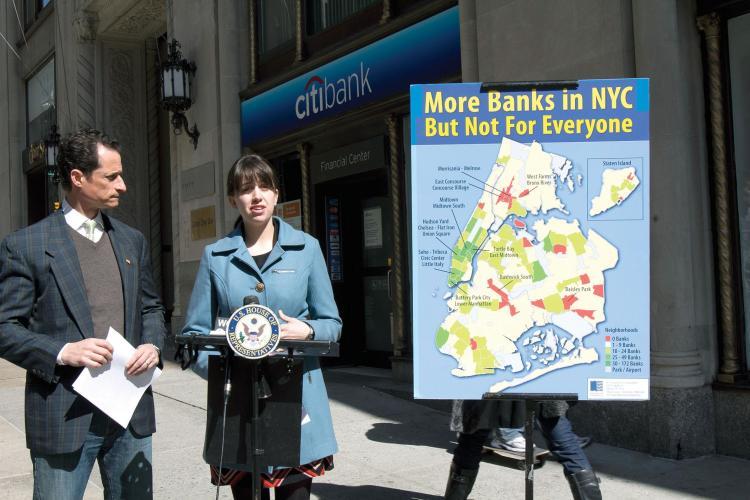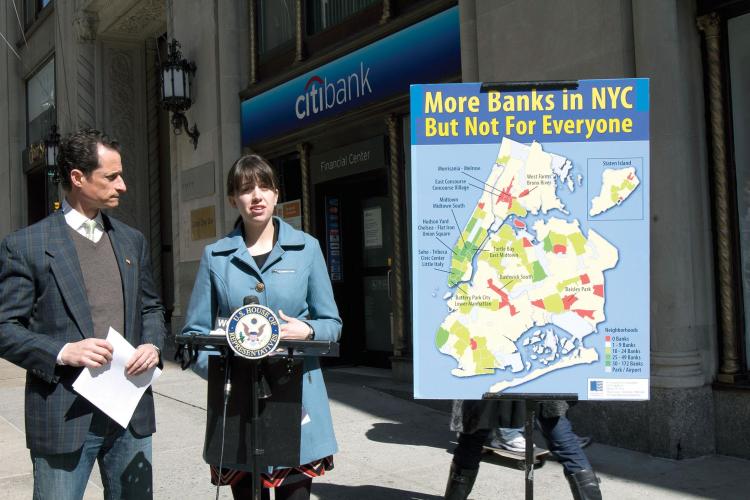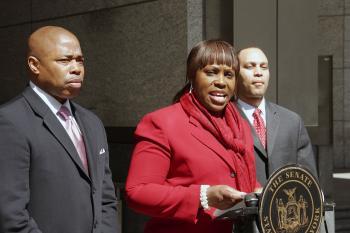Weiner, who is a member of the House Energy and Commerce Committee, joined Megan Ahearn, Consumer Rights Organizer for the New York Public Interest Research Group (NYPIRG), outside of the Citibank branch at 32nd Street and Park Avenue to address the issue of the disparity between the “haves” and the “have-nots” when it comes to bank access.
The report showed a 12 percent rise in the number of bank branches opened since 2006, despite the economic recession. However, the study unveiled a stark discrepancy in the spread of bank branches between wealthy and low-income neighborhoods. While only eight additional banking facilities opened in the poorest neighborhoods, the 20 wealthiest neighborhoods, where the median income is over $73,000, gained 48 new bank branches.
“Between 2006 and 2010, we found in our research that 191 bank branches had opened in New York City. But, when you look carefully … they are opening up in communities that have a great deal of wealth and bypassing communities that are more likely to be lower income,” Weiner said.
The study also indicated that Manhattan had “nearly 40 percent of all the bank growth, more than four times the number in the Bronx,” according to the congressman. “[While] 70 branches opened in Manhattan, only 18 were added in the Bronx,” stated Weiner, pointing out that there is a bank on every single corner of Park Avenue and the 32nd Street.
During the same period, the West Village gained six bank branches, while East Harlem lost a bank branch.
The disparity in bank access matters because when businesses need to expand in the outer boroughs, they generally find much more luck in securing loans by going to a neighborhood bank, Weiner noted.
“If you are trying to explain to someone why a shop would be successful on Myrtle Avenue, you probably are not going to find a bank on Madison Avenue that understands that nearly as well as one from your own neighborhood,” he explained.
Repercussions
More than 825,000 New Yorkers do not have bank or credit union accounts. Limited access to banking in poorer neighborhoods may contribute to this statistic, according to the report. “Consumers who don’t have access to local bank branches end up paying more for financial services and lose opportunities to build a strong credit history,” noted Ahearn.
The disparity in bank access and banking services also has other repercussions. “When consumers only have check cashing outlets, … you may cash your check and lose a very high percentage of your paycheck every pay period. That means there is less money to buy food for your family, or to pay rent,” Ahearn said.
Banks are not doing enough for all of New York City’s communities, asserted Ahearn. “That’s why we need to strengthen the community investment law, so that banks are serving all our communities evenly,” she added, noting that every New Yorker should have access to basic banking services.
The Community Reinvestment Act of 1977 (CRA) that is currently in place is not enough, said Weiner. “We found that the CRA is not being responsive enough to the needs of low-income communities,” he said.
Weiner has proposed a three-pronged, “carrot-and-stick” approach to address the bank access disparity issue. The first measure is to permit bank regulators to penalize banks with few branches in low- to moderate-income neighborhoods by imposing fines and denying mergers and acquisition requests. The money from fines could provide incentives for banks to set up branches in low-income neighborhoods, helping them cover the risks, according to the press statement.
Weiner’s second proposal is to revise the 1977 CRA and the bank examination ratings, as well as to give banks with more branches and services in low- to moderate-income neighborhoods the highest scores.
The third recommendation involves offering incentives to entice banks to open more branches in disadvantaged areas, as well as to offer and promote safe, no-fee banking services to low-income customers.
The CRA needs to be revised so that regulatory agencies, such as the Federal Deposit Insurance Corporation (FDIC) and the Federal Reserve, could entice banks to open more branches in poor neighborhoods, said Weiner.
The chief executive officer of the New York Bankers Association (NYBA), Michael Smith, stated that a bank branch needs to be “profitable on its own after a certain period of time,” according to a New York Daily News report. The NYBA supports programs that provide incentives for banks to open branches and offer services in underserved areas, stated the publication.






